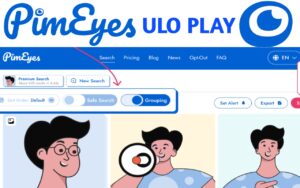What is Pimeyes Website And Its uses With Pros and Cons
What is Pimeyes Website And Its uses. Pimeyes is a controversial online facial recognition search engine that allows users to search for images of individuals across the internet by uploading a photo. The service is marketed as a tool for individuals to find and manage images of themselves online, but it raises significant ethical, privacy, and security concerns. Here’s a detailed overview of PimEyes, its uses, and the pros and cons associated with the service.

What is PimEyes Website and its uses
PimEyes is a facial recognition tool that leverages artificial intelligence to search the internet for images that match a photo provided by the user. By inputting a single image, users can discover where else that image, or others similar to it, appear online. The site scours publicly accessible sites, including social media platforms, blogs, and other websites, to locate matching images.
How PimEyes Works
The platform uses advanced algorithms to analyze facial features and compare them against a vast database of images found on the web. When a user uploads a photo, PimEyes generates a list of URLs where similar images are located. This process relies on sophisticated AI techniques such as deep learning and neural networks, which are trained to recognize and match facial features.
Uses of PimEyes
1. **Reputation Management**: Individuals concerned about their online presence can use PimEyes to discover where their images are being used. This is particularly useful for public figures, professionals, or anyone concerned about unauthorized use of their photos.
2. **Photo Verification**: PimEyes can help users verify the authenticity of images by checking if a photo has been published elsewhere. This can be useful in preventing fraud or catfishing by determining if someone is using a stolen photo.
3. **Content Removal Requests**: By identifying where their photos are being used, individuals can contact website owners to request the removal of unauthorized content, thereby managing their digital footprint.
4. **Security and Investigations**: Law enforcement or cybersecurity professionals might use PimEyes in investigations to track down individuals or verify identities, although this application is fraught with ethical and legal implications.
Pros of PimEyes
1. **Empowers Individuals**: PimEyes provides a tool for people to regain control over their online image. For those concerned about privacy or unauthorized use of their photos, PimEyes offers a way to monitor and manage their digital presence.
2. **Easy to Use**: The platform is user-friendly, requiring only a photo upload to begin the search process. This simplicity makes it accessible to a broad audience, even those with limited technical expertise.
3. **Versatile Applications**: PimEyes can be used for various purposes, from personal reputation management to professional investigations, making it a flexible tool for different needs.
4. **Awareness of Online Presence**: PimEyes can help individuals become more aware of their online presence. It can reveal photos that users might not have known were public, allowing them to take action if needed.
5. **Potential in Security**: For law enforcement and cybersecurity professionals, PimEyes offers a tool to track down individuals or verify identities in certain situations, potentially aiding in investigations.
Cons of PimEyes
1. **Privacy Concerns**: The most significant issue with PimEyes is its potential to violate privacy. The ability to search for and find images of individuals without their consent can lead to misuse, including stalking, harassment, or doxxing. This raises ethical questions about the balance between utility and the right to privacy.
2. **Risk of Misuse**: PimEyes can be misused by malicious actors. For example, someone could use the tool to track down individuals for harmful purposes, or to collect and distribute images without permission.
3. **False Positives**: While PimEyes is advanced, it is not infallible. There is a risk of false positives, where the system incorrectly identifies someone as appearing in an image. This can lead to confusion or unwarranted concerns.
4. **Limited Control Over Data**: Users have little control over how their images are indexed and used by PimEyes. Even if an individual discovers their photo is being used inappropriately, they might have difficulty removing it from the internet, especially if the image is hosted on a site outside of their jurisdiction.
5. **Ethical and Legal Challenges**: The legality of using facial recognition technology like PimEyes varies by country and jurisdiction. Some regions have strict laws regarding the collection and use of biometric data, which PimEyes might be violating. This opens up users and the company to potential legal risks.
6. **Commercialization of Privacy**: PimEyes offers premium services that allow users to monitor images more effectively or remove their data from the database. This commercialization of privacy concerns can be seen as exploitative, forcing individuals to pay for protection against misuse.
7. **Impact on Vulnerable Groups**: Marginalized or vulnerable groups might be disproportionately affected by the misuse of PimEyes. For example, individuals who have been victims of domestic violence or stalking could be re-traumatized if their images are found and exploited through the platform.
Conclusion of Pimeyes
PimEyes is a powerful but controversial tool. While it offers significant benefits, such as helping individuals manage their online presence and aiding in investigations, it also poses serious risks to privacy and security. The ethical and legal implications of its use are complex, and the potential for misuse is high. As facial recognition technology continues to evolve, it will be crucial to address these challenges through robust regulation and the development of ethical standards to protect individuals’ rights while balancing the benefits of such tools.
